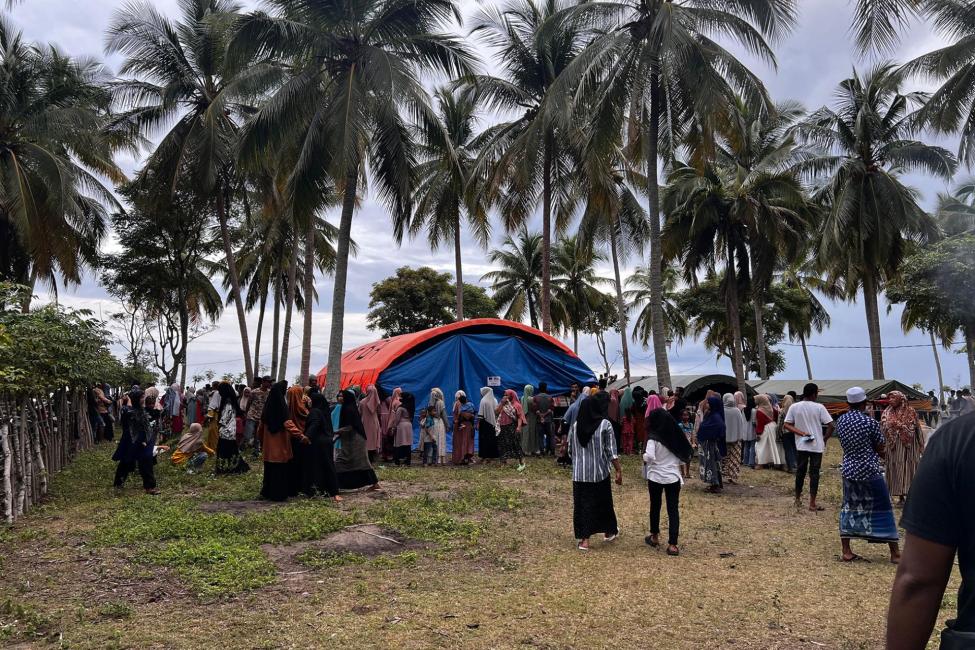-
Who we are
WHO WE AREThe International Organization for Migration (IOM) is part of the United Nations System as the leading inter-governmental organization promoting since 1951 humane and orderly migration for the benefit of all, with 175 member states and a presence in over 100 countries. IOM joined the United Nations system in September 2016.
About
About
IOM Global
IOM Global
-
Our Work
Our WorkAs the leading inter-governmental organization promoting humane and orderly migration, IOM plays a key role to support the achievement of the 2030 Agenda through different areas of intervention that connect both humanitarian assistance and sustainable development.
Cross-cutting (Global)
Cross-cutting (Global)
- Data and Resources
- Take Action
- 2030 Agenda
Deaths on Migration Routes in MENA Highest since 2017: IOM 2022 Data Reveals
Geneva/Berlin/Cairo: Nearly 3,800 people died on migration routes within and from the Middle East and North Africa (MENA) region last year (January-December 2022), the highest number since 2017 when 4,255 deaths were recorded according to newly released data from the International Organization for Migration’s (IOM) Missing Migrants Project (MMP).
The 3,789 deaths recorded in 2022 was 11 per cent higher than the previous year.
The MENA region accounted for more than half of the total 6,877 deaths recorded worldwide by the MMP, according to the new report.
On North African land routes, particularly during the perilous Sahara Desert crossing, 203 deaths were recorded, while an additional 825 deaths occurred on Middle Eastern land routes. Libya registered the highest number of deaths on land routes in North Africa, with 117 fatalities, followed by Algeria (54), Morocco (13), Tunisia (10), and Egypt (9).
The scarcity of official data and limited access to land routes for civil society and international organizations suggests that the actual number of deaths on migratory routes within and from the MENA region is likely much higher than reported.
“Our data shows that 92 per cent of people dying on this route remain unidentified,” said Koko Warner, Director of the Global Data Institute hosting the MMP. “The tragic loss of life on dangerous migration routes highlights the importance of data and analysis in driving action.”
Most deaths on land routes in the region last year occurred in Yemen, where targeted violence against migrants has intensified. Of the 867 deaths recorded on the Horn of Africa-Yemen crossing, at least 795 people, believed to be mostly Ethiopians, lost their lives on the route between Yemen and Saudi Arabia, predominantly in Yemen's Sa’dah governorate at the northern border.
“This alarming death toll on migration routes within and from the MENA region demands immediate attention and concerted efforts to enhance the safety and protection of migrants,” said Othman Belbeisi, IOM MENA Regional Director.
“IOM urges increased international and regional cooperation as well as resources to address this humanitarian crisis and prevent further loss of lives, in line with Objective 8 the Global Compact for Migration (GCM)”
On sea routes from MENA to Europe in 2022, an increasing number of deadly incidents took place after boats departed from Lebanon, destined for Greece and Italy. At least 174 deaths were recorded following these attempts, constituting nearly half of the overall death toll on the Eastern Mediterranean route last year. As many as 84% of those who perished along sea routes remain unidentified, leaving desperate families in search of answers.
In an effort to address the persistent data gaps, IOM Libya's Displacement Tracking Matrix (DTM) launched a system to track incidents reported by key informants in remote areas along key migration routes and Libya's borders in late 2021. This collaboration with the MMP has enabled the inclusion of 52 incidents along the treacherous Sahara Desert crossing in the MMP database. The DTM tool is crucial to addressing the lack of data in remote locations where the testimonies eyewitnesses are the only record of a migrant’s death.
Note to Editors:
GCM objective 8 focuses on "Saving lives and establishing coordinated international efforts on missing migrants." It aims to prevent migrant deaths, address the challenges of missing migrants, and provide support to affected families. IOM is co-chairing the UN Migration Network workstream on missing migrants and humanitarian assistance to migrants in distress, which will produce recommendations for the UN Secretary General’s next GCM progress report. The workstream will conduct regional consultations on missing migrants in 2023, including in the MENA region, to mobilize a response to this issue.
A global report on Missing Migrants Project data for 2022 will be released next week. Missing Migrants Project is a flagship initiative of the Global Migration Data Analysis Centre (GMDAC) within IOM’s Global Data Institute in Berlin, and is the custodian of SDG indicator 10.7.3. The latest Missing Migrants Project data on the MENA region can be found at https://missingmigrants.iom.int/data
|
2018 |
2019 |
2020 |
2021 |
2022 |
|
|
Middle East land routes |
224 |
84 |
3 |
35 |
825 |
|
North Africa land routes |
645 |
724 |
114 |
330 |
203 |
|
Sea routes departing from MENA* |
2,267 |
2,021 |
2,233 |
3,063 |
2,761 |
|
Total |
3,136 |
2,829 |
2,350 |
3,428 |
3,789 |
|
Percentage increase vs 2022 |
20.8% |
33.9% |
61.2% |
10.5% |
-- |
Source: IOM Missing Migrants Project, 2023
*Includes deaths in the Central and Western Mediterranean, on the Eastern Mediterranean departing from Lebanon and Cyprus, and on the Atlantic route to the Spanish Canary Islands.
***
Media contacts:
For more information please contact:
Berlin: Julia Black, jblack@iom.int
Cairo: Mohammedali Abunajela, mmabunajela@iom.int
Geneva: Safa Msehli, smsehli@iom.int

